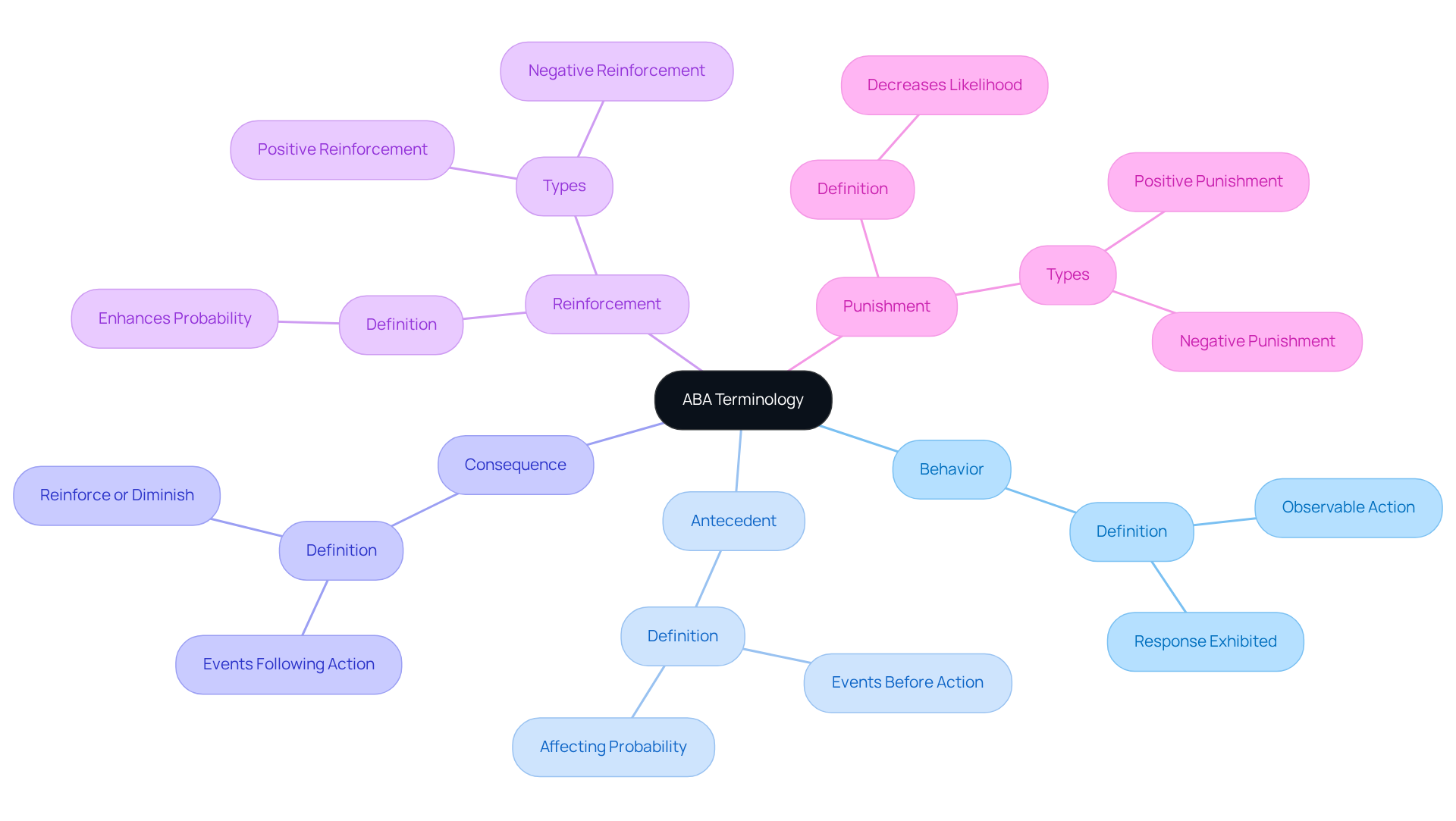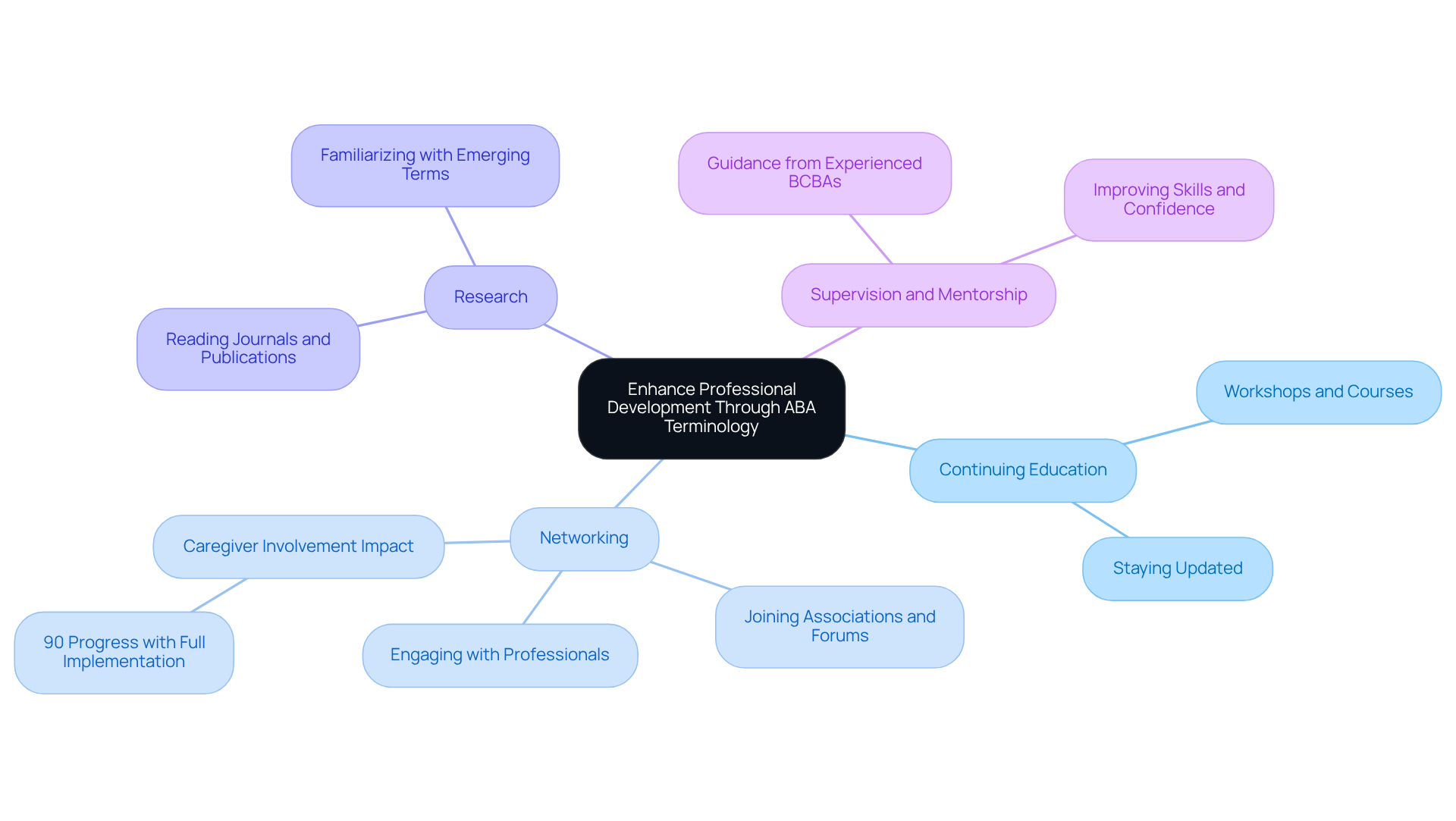October 19, 2025

The article emphasizes the critical role of mastering ABA (Applied Behavior Analysis) terminology in effective healthcare management. A clear understanding and application of fundamental concepts such as behavior, antecedents, and reinforcement not only enhance communication among practitioners but also significantly improve treatment outcomes. Furthermore, this knowledge facilitates professional development through accurate assessments and goal setting.
Consider the demand for Board Certified Behavior Analysts (BCBAs) in today's healthcare landscape. As the need for qualified professionals grows, so does the importance of a solid grasp of ABA terminology. This expertise is essential for fostering collaboration and ensuring that all team members are aligned in their approach to patient care.
Reflect on your current hiring challenges. Are you confident that your team possesses the necessary ABA knowledge to drive success? Utilizing platforms like Hire ABA can streamline your recruitment process, ensuring you find candidates who are not only skilled but also well-versed in the language of ABA.
In conclusion, mastering ABA terminology is not just an academic exercise; it is a vital component of effective healthcare management. By prioritizing this knowledge, practitioners can enhance communication, improve treatment outcomes, and foster professional growth. Embrace the opportunity to elevate your team's capabilities and ensure your practice thrives in this dynamic field.
Mastering the language of Applied Behavior Analysis (ABA) is not merely about learning definitions; it is a crucial element of effective healthcare management that can significantly enhance treatment outcomes. By exploring core concepts such as behavior, reinforcement, and punishment, professionals can cultivate clearer communication and collaboration among practitioners, ultimately benefiting clients.
Yet, the challenge persists: how can behavior analysts ensure they are not only using ABA terminology correctly but also applying it meaningfully in therapeutic contexts? This article delves into the nuances of ABA terminology, providing insights and strategies for professionals eager to elevate their practice and improve patient care.
To master ABA terminology, it is crucial to familiarize yourself with the following core concepts:
Comprehending ABA terminology is essential for effective communication among Board Certified Behavior Analysts and other professionals in the field. Using clear ABA terminology not only improves collaboration but also significantly affects treatment outcomes. Have you considered how clear communication can enhance your practice? For instance, when Board Certified Behavior Analysts employ clear language, they can more effectively recognize target actions and customize interventions accordingly, resulting in enhanced outcomes for clients.
Historically, ABA terminology has been utilized to assist children with autism since the 1960s, highlighting the long-standing significance of mastering this language in practice. Behavior analysts utilize data to make treatment-focused decisions based on measurable elements of behavior, demonstrating the practical use of ABA language in data-informed decision-making. Engaging with consistent ABA terminology is essential for professional growth and development, ensuring that practitioners remain informed and effective in their roles. Real-world examples show that effective communication using ABA terminology fosters a shared understanding among practitioners, ultimately benefiting the individuals receiving care. Mastery of these terms empowers BCBAs to implement ABA strategies more effectively, ensuring that interventions are both appropriate and impactful.

To effectively apply ABA terminology in therapeutic contexts, it is crucial to consider the following strategies:
Behavioral Assessments: Utilize precise terminology to describe behaviors during assessments. For instance, when observing a child, document antecedents and consequences to identify behavioral patterns that can inform treatment strategies. Research indicates that ABA-based interventions have a standardized mean difference of d=0.11 for socialization, emphasizing the importance of accurate assessments in achieving positive outcomes.
Goal Setting: Clearly articulate goals using ABA terminology. Instead of a vague objective like 'improve communication,' specify measurable targets such as 'increase the frequency of requesting items using verbal prompts.' This clarity aids in tracking progress and adjusting interventions as needed. According to studies, children engaged in early, intensive therapy typically receive around 25 to 40 hours weekly, leading to significant improvements in communication skills.
Data Collection: Implement methods that utilize ABA terminology in data collection. When recording data, indicate whether the behavior was reinforced or punished, and detail the antecedent conditions. This specificity enhances the accuracy of data analysis and informs evidence-based decisions. A meta-analysis of 14 randomized controlled trials showed significant improvements in social skills and communication among children undergoing ABA therapy, highlighting the importance of thorough data collection.
Parent Training: Educate parents on ABA terminology to ensure they grasp the strategies being implemented. Use terms like 'reinforcement' and 'antecedent' to explain how they can effectively support their child's learning at home, fostering collaboration and consistency in therapeutic approaches. As one BCBA noted, "Active family involvement supports progress in ABA therapy," underscoring the critical role parents play in their child's development.
By incorporating ABA language into daily practice, BCBAs can improve clarity and effectiveness in their interventions, ultimately resulting in better patient outcomes.

To enhance professional development through ABA terminology, consider the following strategies:
Continuing Education: Did you know that the demand for Board Certified Behavior Analysts (BCBAs) is at an all-time high? Participating in workshops and courses that emphasize ABA terminology and its practical applications not only deepens your understanding but also keeps you updated on the latest developments in the field.
Networking: Are you actively engaging with fellow professionals? Discussing language and its implications is crucial in our field. Joining ABA associations or online forums facilitates the exchange of insights and fosters learning from peers. This collaborative approach is vital, especially considering that 90% of individuals show notable progress when recommended hours of Applied Behavior Analysis therapy are fully implemented with caregiver involvement.
Research: How familiar are you with the latest research in ABA? Staying updated by reading relevant journals and publications allows you to familiarize yourself with emerging terms and concepts, thereby enhancing your knowledge base and professional vocabulary.
Supervision and Mentorship: Have you sought guidance from experienced Board Certified Behavior Analysts? Engaging in supervision or mentorship can significantly enhance your comprehension of language in practice, ultimately improving your skills and confidence.
By actively engaging with the concepts of ABA terminology, BCBAs can significantly enhance their professional capabilities, leading to improved patient care and outcomes.

Mastering ABA terminology is not merely an academic exercise; it is a crucial element for effective healthcare management and therapeutic outcomes. Understanding key concepts such as behavior, antecedents, consequences, reinforcement, and punishment enables professionals to communicate clearly, make informed decisions, and tailor interventions that genuinely meet the needs of clients. The significance of employing precise ABA language cannot be overstated, as it directly correlates with improved collaboration among Board Certified Behavior Analysts and enhanced treatment results.
This article emphasizes several strategies for applying ABA terminology in therapeutic contexts, including:
Each of these elements contributes to a more structured and effective approach to therapy, underscoring the necessity of clear communication in achieving positive outcomes. By integrating ABA terminology into daily practices, professionals can enhance their ability to analyze behaviors, track progress, and foster a collaborative environment with families.
In conclusion, mastery of ABA terminology is essential for professionals aiming to excel in their field. It not only facilitates better communication but also empowers practitioners to deliver high-quality care. As the demand for skilled Board Certified Behavior Analysts continues to grow, investing in education, networking, and mentorship will further enhance professional development. Embracing these practices will ultimately lead to improved patient outcomes and a more profound impact on the lives of those receiving care.
What is the definition of behavior in ABA terminology?
In ABA terminology, behavior is defined as any observable action or response exhibited by an individual.
What is an antecedent in the context of ABA?
An antecedent refers to events or conditions that occur before an action, which can affect the likelihood of that action happening.
How are consequences defined in ABA?
Consequences are events that follow an action, which can either reinforce or diminish the future occurrence of that action.
What is reinforcement in ABA, and what are its types?
Reinforcement is a process that increases the probability of a behavior being repeated. It can be classified as positive reinforcement (adding a stimulus) or negative reinforcement (removing an aversive stimulus).
What does punishment mean in ABA, and how is it categorized?
Punishment is a process that decreases the likelihood of a behavior being repeated. It is categorized as positive punishment (adding an aversive stimulus) or negative punishment (removing a pleasant stimulus).
Why is understanding ABA terminology important for professionals in the field?
Understanding ABA terminology is crucial for effective communication among Board Certified Behavior Analysts and other professionals, improving collaboration and significantly affecting treatment outcomes.
How has ABA terminology been historically significant?
ABA terminology has been used to assist children with autism since the 1960s, highlighting its long-standing importance in practice.
How do behavior analysts use ABA language in their decision-making?
Behavior analysts use data to make treatment-focused decisions based on measurable elements of behavior, demonstrating the practical application of ABA language in data-informed decision-making.
What is the impact of clear communication using ABA terminology?
Clear communication using ABA terminology fosters a shared understanding among practitioners, ultimately benefiting the individuals receiving care.
How does mastery of ABA terms benefit Board Certified Behavior Analysts (BCBAs)?
Mastery of ABA terms empowers BCBAs to implement ABA strategies more effectively, ensuring that interventions are both appropriate and impactful.
Our expert recruitment strategies and AI-driven sourcing ensure that you receive top-notch candidates quickly, without compromising on quality. Whether you’re looking for BCBAs, Clinical Directors, or RBTs, we’ve got you covered.